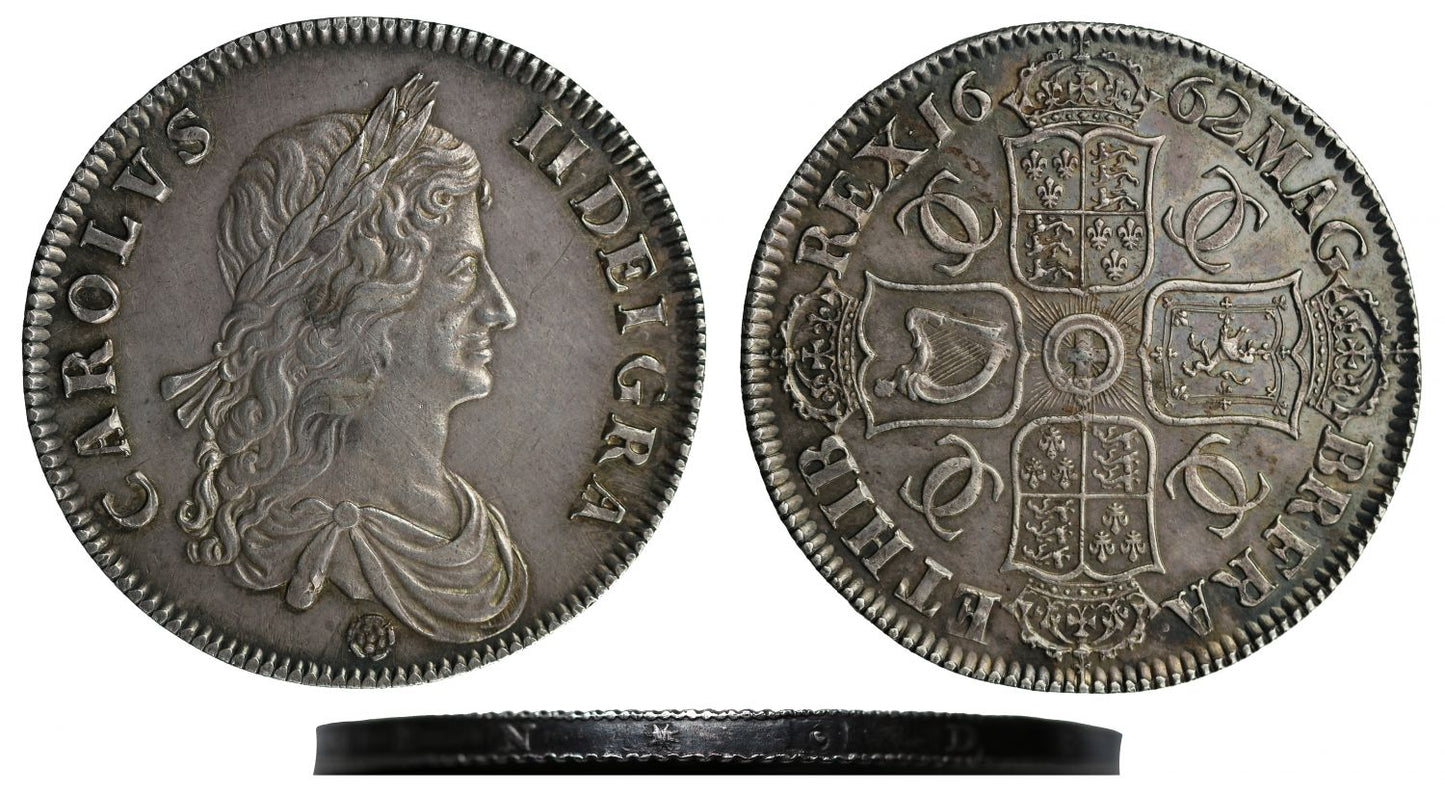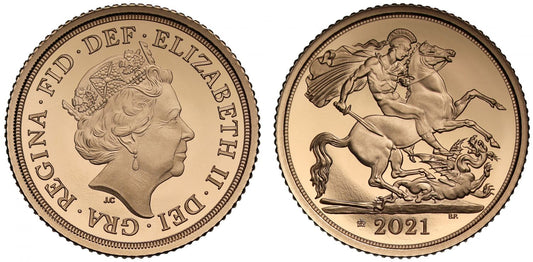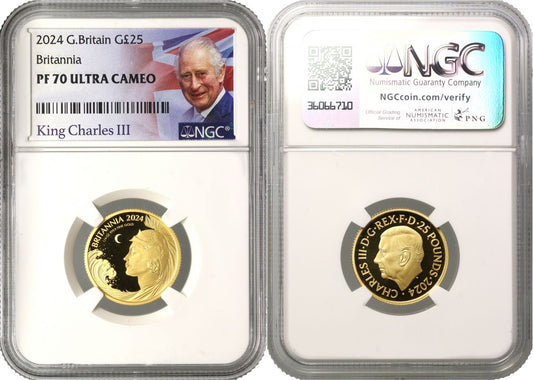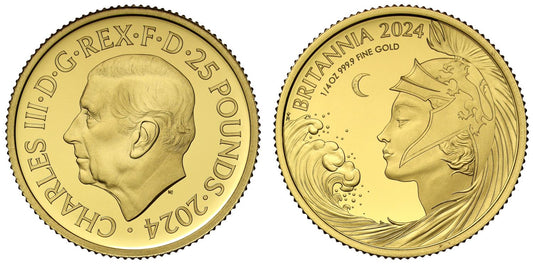FAQs
What makes a coin valuable?
I have coins to sell, what’s the next step?
How will my purchases be shipped?
What happens if I’m not entirely happy with my purchase?
Charles II 1662 fine work Crown
Charles II (1660-85), silver Crown, struck like a proof and of finer work than a currency piece, 1662, on a specially prepared flan by Roettier, laureate and draped bust right, very finely detailed hair with distinct curls, well defined features on face, rose below, Latin legend with fish tailed lettering and distinct toothed border surrounding, CAROLVS . II. DEI. GRA. rev. inverted die axis, crowned cruciform shields, pairs of interlinked Cs in angles, garter star at centre, ten strings to Irish harp, date either side of top crown, Latin legend and toothed border surrounding, .MAG. BR. FRA. ET. HIB. REX. all stops a little weak both sides, edge inscribed in raised letters between grained borders, lettering of inverted orientation to obverse and spread out evenly, .DECVS. ET. TVTAMEN* some collar slippage evident on doubling of stop after ET, weight 29.84g (Broad BC.2 this coin; cf.L&S 4, page 7 notes, ESC 16 R5; Bull 341 R5; S.3350). Dark peripheral tone around rim, attractive steel grey colour across rest of obverse with mint brilliance, a couple of spots in hair, some light adjustment marks visible in hair and near parts of rim, reverse with a darker tone and light flecking, otherwise struck with a very well-defined rim and edge, border teeth strong, the only weakness being the stops, extremely fine with this grade of preservation extremely rare to achieve for this period of minting.
The Latin legends on this coin translate as "Charles the Second, by the grace of God" on the obverse, "King of Great Britain, France and Ireland" on the reverse, and finally on the edge "An ornament and a safeguard" a reference to the prevention of the edge being clipped or mutilated by the unscrupulous.
The new issue of machine made "milled" coins were introduced to the public in the latter part of the year 1662, with the production of these English silver Crowns, the first denomination issued proudly by this method. The smaller denominations of Halfcrown and Shilling would follow dated 1663 with the Sixpence not arriving till 1674, the Twopence in 1668 and other small silver from 1670.
It seems there was good reason for the issue of the silver Crowns first as in the year 1662 King Charles II sold the town of Dunkirk back to the French for five million French Livres, the town having been captured by the Parliamentarian forces in 1658. This created a massive influx of silver into the Mint to convert to British silver, reportedly 1,500,000 silver Ecus transported in 300 chests from December 1662 until mid-1663 at a total weight of 108,636 pounds. Naturally the biggest denomination in silver would be the most efficient way to work through the supply, hence the Crown being the coin of choice. There are two distinct varieties of silver Crown dated 1662 as well as a number of more minor variations, the main one being whether the coin carries a rose under the bust or not. It has often been conjectured that the rose indicates silver supplied from the west country of England, so perhaps the non-rose variety would mean silver from the Dunkirk sale, however, research is ongoing to find documentary evidence, as the West Country theory seems to be more of an assumption and extrapolation of when the rose mint mark was used for the Truro and Exeter area for provincial silver coins in the reign of Charles I some 20 years earlier. This sentiment was echoed by Alan Broad in his article "1662 Rose below" who also remarked that the old Commonwealth hammered cross and harp money was also being recoined so that was more likely a source for the rose below mark.
The Roettier brothers from Holland had come to prominence as engravers during the exile of Charles II in the Parliamentarian period, and were held in such favour by Charles that he promised them positions in his Mint at the Restoration. This famously led to the competition in 1663 between the former Parliamentarian engraver, the highly regarded Thomas Simon and the brothers Roettier. However, the fact Simon had worked for Oliver Cromwell meant his position was doomed from the start leading to his famous "Petition Crown" to the King dated 1663, arguably the most magnificent piece of milled engraving work in the British coin series, to no avail. The Roettiers were in favour and Simon was relegated to working on the small silver only.
Proof pieces of pleasure would have been struck first for very important people connected with the Mint, more importantly to give a preview of how the new coinage would look, and for its artistic merit to be appreciated as it was made by the new machine-made method.
Provenance:
Ex A H Baldwin, Fixed Price List, Winter 2011-12, item BM067.
A "possible" provenance chain for this piece was listed in the Baldwin fixed price list as the obverse seems to match the piece in H M Lingford lot 279, and though the reverse die is the same type, the border teeth have a slight discrepancy probably not caused by the plaster cast production method for plates used at that time, therefore the provenance remains elusive other than that discussed below.
A close-up image of part of this coin was illustrated in the article "1662 Rose Below" by Alan Broad featured in the Seaby Coin and Medal Bulletin of March 1981, pages 60-65. The BC.2 variety on page 62 depicts the example offered for sale herewith, with the B and C obverse types clearly being seen as the rarest of the 1662 issues over the more prolific A type. The BC.2 variety significantly seems to be the only one to show a fishtail style of lettering which seems consistent with the proof type issues as defined further by Roderick Richardson in his article "J. Roettier, Patterns & Proofs of Charles II Crowns, Notes by Roderick Richardson" self-published Summer 1998. Of the varieties listed by Mr Richardson this coin carries obverse C which he records paired with his reverse 4, RRSC4 which is also ESC 16, and the fishtailed lettering explained by a striking without a collar. However, as the edge is so perfectly struck and the rim with full border teeth, the coin was certainly struck with an edge collar and perfectly. It is perhaps more likely that the fishtailed lettering results from the use of the medallion workshop tools and a screw-press to produce these pieces of pleasure, rather than the currency workshop tools.
The other intriguing aspect of this coin is the reverse does not match the die of Mr Richardson's reverse 4 in his article, and the coin herewith has a distinctive letter E in ET on the reverse which is turned quite dramatically out of alignment with the T following. This is something more akin to Richardson reverse 1 usually found on the gold proofs, but with other smaller details not quite matching.
This coin is obviously a very early production of the 1662 dated coins, struck from a well-defined die seemingly reserved for proof pieces of finer work, and we have only ever seen one or maybe two others struck from this die combination of Broad BC.2. An extreme rarity.
FAQs
What makes a coin valuable?
I have coins to sell, what’s the next step?
How will my purchases be shipped?
What happens if I’m not entirely happy with my purchase?













